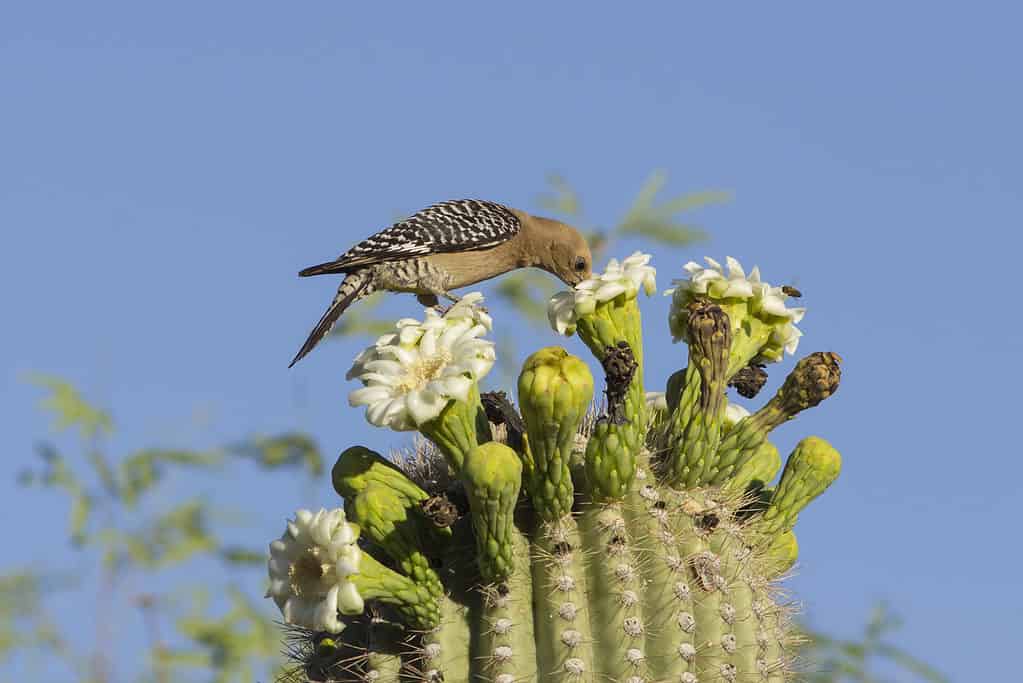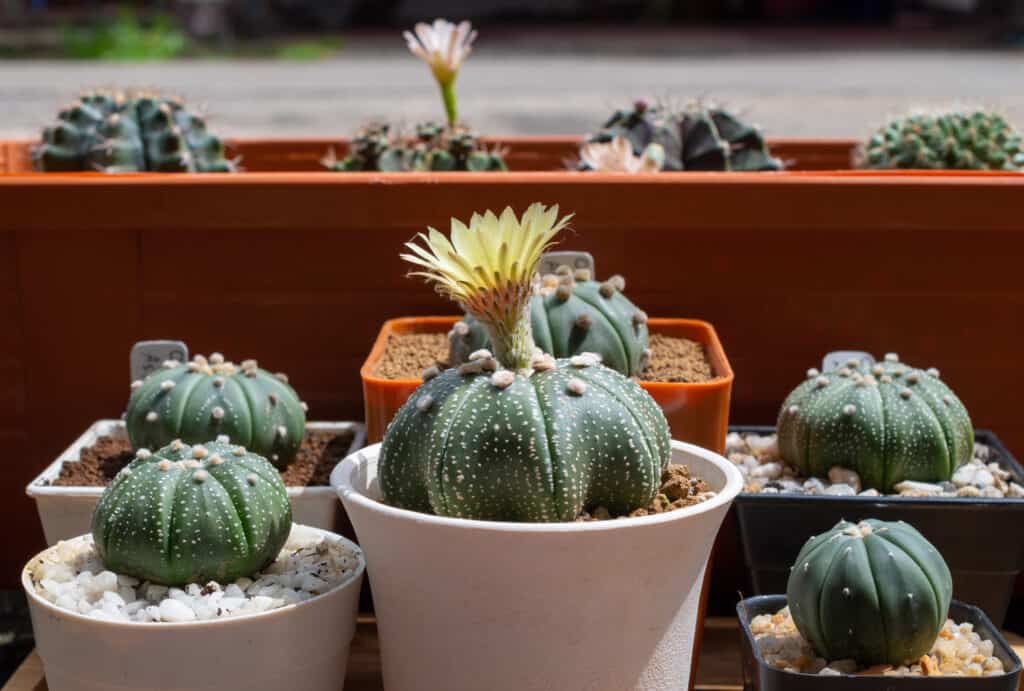You might be surprised to learn that, technically speaking, every cactus is a flowering cactus. Despite their sometimes plain and thorny appearance, these plants often produce exquisite and fragrant flowers. The flowers that a cactus produces will vary in size, shape, and color depending on the species.
In this article, we’ll talk about when flowering cacti bloom and the seasonal changes that trigger them to do so. We’ll also talk about a few species of cacti that you can grow at home for their gorgeous, seasonal blooms.
When Do Flowering Cacti Bloom?
While all cacti can produce flowers, the age and frequency at which they do so can vary wildly. Some cacti, like the Christmas cactus will mature after only a few years and will bloom yearly thereafter if cared for properly. Other species, like the columnar saguaro cactus, take more than 30 years to reach flowering age. Their trumpet-shaped blooms are rare to behold, appearing for only one night before they close and fade away.
The flowering age of your cactus is only one part of the picture. While your plant must have reached flowering age, it must also receive proper care to begin producing blooms. The proper amount and intensity of sunlight are major determining factors of whether a cactus will bloom. Temperature is another important variable. Because they produce flowers seasonally, matching the seasonal climate of your plant’s native habitat will help induce flowering. Cacti can be finicky when it comes to flowering, so if you’d like to help your plant flower, choose a species that grows in conditions that closely match those of your area.

A Gila woodpecker perched atop a group of trumpet-shaped saguaro cactus flowers. These long-lived cacti produce ephemeral flowers that open at night and last only a single day.
©iStock.com/tntphototravis
4 Interesting Species of Flowering Cacti to Grow at Home
There are many species of flowering cacti readily available for purchase, either online or in person at your local nursery or garden center. If you’re looking to grow a cactus at home with the hopes of seeing it bloom, the species below are worth seeking out.
Queen of the Night (Epiphyllum oxypetalum)
This species of cactus is quite different from what you might expect. Rather than grow in a sunny, arid location, this cactus makes its home in the jungles of Central and South America. It is often referred to as an orchid cactus. Like many species of orchids, this cactus is an epiphyte. This means that it grows outside of the soil, instead anchoring itself to stones or other living plants. Without contact with the soil, the cactus must derive all of its water and nutrients from passing fog, mist, or rainwater.
While its tropical nature sets it apart from other flowering cacti, the main appeal of the Queen of the Night is still, of course, its incredible blooms. True to its name, this cactus produces flowers that only bloom at night. If all of its needs are met, it will produce long, funnel-shaped buds that open to reveal intricate, fragrant flowers. Each bud blooms only once before closing. If pollinated, the flower gives way to a large, oblong, and edible fruit. Check out the video below of a Queen of the Night flower blooming in timelapse!
Although it is most often found above ground level in nature, this species can grow just fine in a pot full of well-draining, very airy potting mix. It will need quite a bit more water than a desert cactus. Additionally, because it is an understory plant, it cannot tolerate full sun exposure. Instead, it prefers several hours per day of indirect lighting. Hailing from the subtropics, Queen of the Night can grow outdoors year-round in USDA zones 10 and 11. Although it can handle temperate winters, this species cannot withstand freezing temperatures. Be sure to bring your plant indoors when temperatures begin to drop.
Star Cactus (Astrophytum asterias)
Also known as the sand dollar cactus, the star cactus (Astrophytum asterias) is a popular choice among succulent and cactus growers. It grows well in pots, reaching a mature size of about 6 inches in diameter. Although it can be challenging to grow, it will flower readily each year if its needs are met.
The star cactus grows solitarily, producing a single, swollen, hemispheric stem. Each one is divided into eight distinct sections. Rather than spines, each of these sections produces small tufts of hair in a single row that runs down its center. This desert cactus species flowers throughout the spring. From March through May, expect a happy star cactus to produce a feathery, yellow, funnel-shaped flower with a red or orange center. Each flower persists for only a day or two.
Although it will need regular watering throughout the growing season to encourage it to flower, the star cactus is susceptible to root rot in the presence of too much moisture. If you’re planning on growing one at home, you should be sure that its soil is very well draining. In the wild, the star cactus grows in environments with loose, stony, clay, or loam soils. It is an endangered species in the wild, so be sure that your cactus was seed-grown and not collected, if possible.

A group of
Astrophytum asteriascacti in various pots. During the spring, a happy star cactus will produce a feathery, funnel-shaped flower from its center. With regular watering, it may even produce additional flowers during the summer.
©iStock.com/Boyloso
Spiny Pincushion Cactus (Mammillaria spinosissima)
Another solitary species, the spiny pincushion cactus (Mammillaria spinosissima) is wonderful for container planting. It is fast-growing and easy to propagate by division of the many small pups that form readily around the base of the parent plant.
This species is columnar in growth habit, growing to heights of about 16 inches and widths of about 4 inches. In the spring, the spiny pincushion cactus is likely to produce several small, pink, or purple flowers around the top of its stem. Because of its fast-growing nature, a single cactus and its offsets can quickly fill out a container and provide a multitude of beautiful spring blooms. Be sure to carefully repot your cactus every couple of years as its container becomes crowded.
The spiny pincushion cactus, like other desert cacti, is very sensitive to overwatering. Be sure to water only when the soil has dried out and avoid standing water at all costs. If your plant’s container has a catch tray underneath, be sure to empty it after every watering. In the winter, as the cactus goes dormant, allow the soil to dry out completely and resume watering in the spring.

If cared for properly, spiny pincushion cacti will produce a crown of flowers around the top of their stems.
©The_AA’s/Shutterstock.com
Miniature Chin Cactus (Gymnocalycium bruchii)
This tiny clumping cactus species (Gymnocalycium bruchii) is native to Argentina. At maturity it grows only to about one and a half inches in height, making it great for growing on a window sill or in a compact rock garden. Its little, pink flowers often grow to the size of the cactus itself!
This compact flowering cactus becomes completely covered in a coat of bristly spines that protects its bluish-green stem from harm and gives it a knitted appearance. As it ages, it will readily produce offsets around its base. Each of these offsets will eventually grow to maturity and produce flowers just like their parent cactus. Watching a cluster of happy chin cacti produce their blooms is a very rewarding experience.
To encourage your chin cactus to flower in the spring, you’ll need to ensure that it receives the right amount of sunlight throughout the day. This species grows best in strong sunlight, preferring morning and evening sun with shading through the intense afternoon hours. Striking a balance is important, as too much direct sun can harm the cactus while too little won’t give provide enough energy to produce flowers. If you’ve had to overwinter your cactus indoors, be sure to reintroduce it to direct sunlight slowly as you would when hardening off any other plant.

A mature miniature chin cactus (
Gymnocalycium bruchii) bearing a small cluster of pink flowers. Each of the small offsets surrounding its base will eventually mature to bear flowers as well.
©Phanneko/Shutterstock.com
Thank you for reading! Have some feedback for us? Contact the AZ Animals editorial team.








